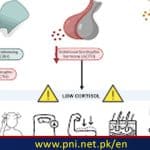ISLAMABAD, April 13 (Online): A new study found concerning levels of toxic PFAS, or “forever chemicals,” in seafood.
PFAS are found in many foods, household, and personal products and are widely present in the environment.
These human-made substances are the focus of a growing body of research given their potential toxicity and associations with serious health issues.
The authors of the study do not suggest people stop eating seafood but urge more research into the effects of these chemicals in humans.
Per- and polyfuoroalkyl substances, or PFAS, are a class of human-made chemicals that are considered “forever chemicals” because they remain in the environment for a long time.
Research into the effects of PFAS in humans is ongoing, as exposure to these chemicals has been associated with a range of serious health conditions.
Certain foods may contain forever chemicals, and depending where you live, your drinking water may contain PFAS. Forever chemicals are also found in some types of food packaging.
Now, research shows the risk of PFAS exposure is even greater for people who consume a heavy-seafood diet.
The study’s authors do not suggest people should avoid eating fish entirely, since seafood has many health benefits and PFAS are so ubiquitous in the environment, in general.
The study’s findings were published April 12 in the journal Exposure and Health.
Seafood consumption and PFAS exposure
The researchers investigated the eating habits and PFAS exposure of people living in Portsmouth, NH, an area in which seafood consumption is especially popular. The study consisted of two parts.
The researchers conducted a survey of 1,829 NH residents in June 2021 to learn the types of seafood they were consuming and how much. Included in the survey was seafood consumption data from adults and children ages 2–11.
Among the adults, 95% reported eating seafood within the last year, most often:
shrimp
haddock
salmon
canned tuna
Researchers also purchased and analyzed a “seafood basket” of the most commonly consumed types of seafood from a Portsmouth market for analysis and detected 26 types of PFAS compounds in the purchased foods.
For shrimp and lobster, concentrations of PFAS ranged from below the limit of detection to 1.74 and 3.30 ng/g, respectively.
These findings suggest that people who eat a lot of seafood could, therefore, consume additional PFAS concentrations.
What are the hazards associated with PFAS?
Other than their toxicity, much remains unknown about the effects of PFAS at this time.
Still, the Environmental Protection Agency (EPA) recommends reducing your exposure to PFAS as much as you can.
The study’s senior investigator, Megan Romano, PhD, associate professor of epidemiology at the Geisel School of Medicine at Dartmouth College, explained to Medical News Today that PFAS are “a large family of highly persistent, human-made chemicals that feature a carbon-fluorine backbone.”
They date back nearly eight decades and are used in various water, stain, or grease-resistant consumer products.
“PFAS influence a wide range of biological systems within the body and have a wide range of adverse health impacts,” Romano said.
“We are learning more about the health effects of PFAS every day, but research has demonstrated associations of PFAS with higher cholesterol levels, small decreases in birth weight, pregnancy-induced hypertension, a reduced antibody response to vaccines, and even kidney and testicular cancer.”








